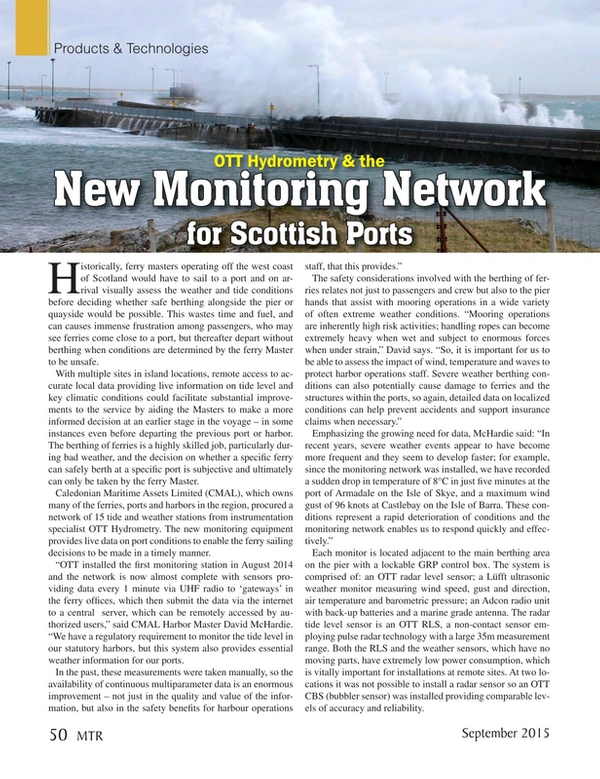
OTT Hydrometry & the New Monitoring Network for Scottish Ports
Historically, ferry masters operating off the west coast of Scotland would have to sail to a port and on arrival visually assess the weather and tide conditions before deciding whether safe berthing alongside the pier or quayside would be possible. This wastes time and fuel, and can causes immense frustration among passengers, who may see ferries come close to a port, but thereafter depart without berthing when conditions are determined by the ferry Master to be unsafe.
With multiple sites in island locations, remote access to accurate local data providing live information on tide level and key climatic conditions could facilitate substantial improvements to the service by aiding the Masters to make a more informed decision at an earlier stage in the voyage – in some instances even before departing the previous port or harbor. The berthing of ferries is a highly skilled job, particularly during bad weather, and the decision on whether a specific ferry can safely berth at a specific port is subjective and ultimately can only be taken by the ferry Master.
Caledonian Maritime Assets Limited (CMAL), which owns many of the ferries, ports and harbors in the region, procured a network of 15 tide and weather stations from instrumentation specialist OTT Hydrometry. The new monitoring equipment provides live data on port conditions to enable the ferry sailing decisions to be made in a timely manner.
“OTT installed the first monitoring station in August 2014 and the network is now almost complete with sensors providing data every 1 minute via UHF radio to ‘gateways’ in the ferry offices, which then submit the data via the internet to a central server, which can be remotely accessed by authorized users,” said CMAL Harbor Master David McHardie. “We have a regulatory requirement to monitor the tide level in our statutory harbors, but this system also provides essential weather information for our ports.
In the past, these measurements were taken manually, so the availability of continuous multiparameter data is an enormous improvement – not just in the quality and value of the information, but also in the safety benefits for harbour operations staff, that this provides.”
The safety considerations involved with the berthing of ferries relates not just to passengers and crew but also to the pier hands that assist with mooring operations in a wide variety of often extreme weather conditions. “Mooring operations are inherently high risk activities; handling ropes can become extremely heavy when wet and subject to enormous forces when under strain,” David says. “So, it is important for us to be able to assess the impact of wind, temperature and waves to protect harbor operations staff. Severe weather berthing conditions can also potentially cause damage to ferries and the structures within the ports, so again, detailed data on localized conditions can help prevent accidents and support insurance claims when necessary.”
Emphasizing the growing need for data, McHardie said: “In recent years, severe weather events appear to have become more frequent and they seem to develop faster; for example, since the monitoring network was installed, we have recorded a sudden drop in temperature of 8°C in just five minutes at the port of Armadale on the Isle of Skye, and a maximum wind gust of 96 knots at Castlebay on the Isle of Barra. These conditions represent a rapid deterioration of conditions and the monitoring network enables us to respond quickly and effectively.”
Each monitor is located adjacent to the main berthing area on the pier with a lockable GRP control box. The system is comprised of: an OTT radar level sensor; a Lüfft ultrasonic weather monitor measuring wind speed, gust and direction, air temperature and barometric pressure; an Adcon radio unit with back-up batteries and a marine grade antenna. The radar tide level sensor is an OTT RLS, a non-contact sensor employing pulse radar technology with a large 35m measurement range. Both the RLS and the weather sensors, which have no moving parts, have extremely low power consumption, which is vitally important for installations at remote sites. At two locations it was not possible to install a radar sensor so an OTT CBS (bubbler sensor) was installed providing comparable levels of accuracy and reliability.
(As published in the September 2015 edition of Marine Technology Reporter - http://www.marinetechnologynews.com/Magazine)
Read OTT Hydrometry & the New Monitoring Network for Scottish Ports in Pdf, Flash or Html5 edition of September 2015 Marine Technology
Other stories from September 2015 issue
Content
- 20 Teams Vie for Wave Energy Prize page: 12
- Makai Expands Marine Corrosion Lab page: 14
- The Lowdown on Ocean Acidification page: 16
- Riding the Waves and Tides to a Cleaner Energy Future page: 20
- Maritime Surveillance in the New Millennium page: 24
- Tackling Subsea Blockages page: 30
- Extreme Sampling: Hadal Trenches page: 34
- Injecting 45 Years of New Life page: 40
- ROV Put to the Test page: 46
- OTT Hydrometry & the New Monitoring Network for Scottish Ports page: 50
- Accelerating Mapping, Surveys with High Speed ROV Ops page: 52
- ASI Marine & its Mohican ROV perform Deepest Tunnel Inspection page: 53
- QINSy page: 56
- EIVA NaviSuite page: 57
- The Sustainable Ocean Summit set for Singapore page: 59


